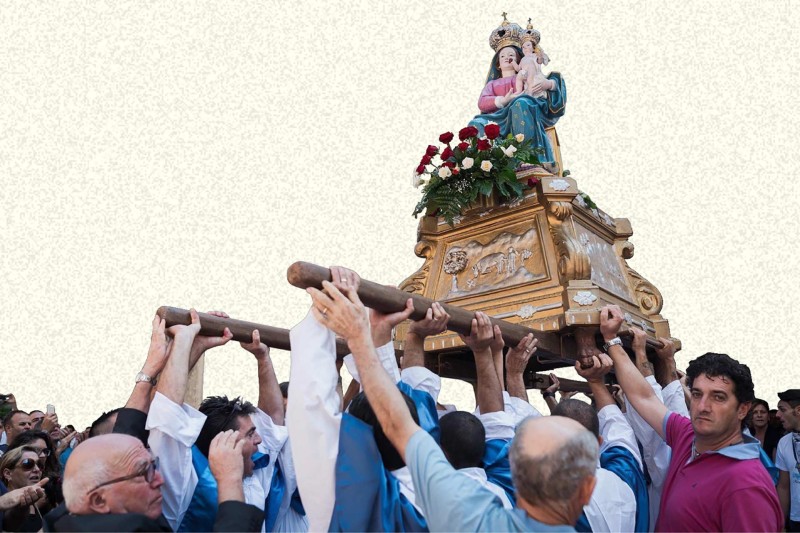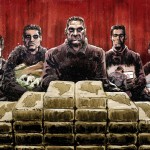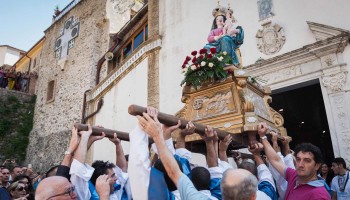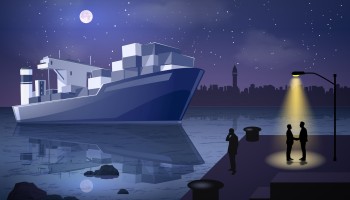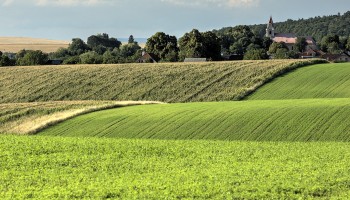What is the 'Ndrangheta?
Once seen as a less organized version of the Sicilian Cosa Nostra, the 'Ndrangheta has risen to become not only Italy’s most powerful mafia but also one of the largest and most sophisticated criminal organizations in the world.
Made up of a sprawling network of 'ndrina, or clans, rooted in Calabria at the toe of boot-shaped Italy, the syndicate is believed to rake in as much as US$60 billion annually — roughly equivalent to the GDP of Croatia.
The group’s interests run the spectrum of economic activity, from outwardly legal enterprises in construction, green energy, and waste management to criminal schemes involving fraud, extortion, high-level corruption, and trafficking in humans and weapons.
However, academic studies have suggested that drugs are the 'Ndrangheta’s biggest earner, with the group controlling some of the world’s most lucrative trafficking routes.
According to an estimate by Italy’s parliament, the organization may dominate more than 80 percent of the European cocaine trade, and its operatives have been detected at major ports on nearly every continent.
’Ndranghetisti have also long been known as skilled money launderers, navigating the global financial system with ease and using complex ownership structures and financial secrecy laws to conceal the origins of their wealth.
“The ’Ndrangheta is among the richest and most powerful organized crime groups at a global level. It has a dominant position on the European cocaine market due to excellent relations with the producers [and] reproduces abroad perfect copies of its operational structures. The ’Ndrangheta [...] has repeatedly proven its skill in infiltrating political and economic environments and its remarkable capacity for corruption.
Europol & Guardia di Finanza, 2013
Where did the 'Ndrangheta come from?
'Ndrangheta legend holds that the organization can be traced back to the 16th century, with the arrival in Italy of three Spanish knights who went on to found the so-called Honored Societies: the Sicilian Mafia, the Neapolitan Camorra, and the Calabrian 'Ndrangheta.
The FBI, however, says the 'Ndrangheta was formed in the 1860s, when a group of Sicilian outlaws set up a base in Italy’s Aspromonte Mountains — a rugged landscape that offered ideal cover for the banditry that had seen them banished from their Sicilian homelands.
Historical court documents from Calabria reveal that by the turn of the 1900s, the 'Ndrangheta was fast becoming an integral part of rural Calabrian life, and an increasing concern for local authorities. Although its activities now span the globe, the group’s beating heart — and the power base to which all members must pay tribute — remains in Calabria.
Like many Calabrian dialect words, “'Ndrangheta” is believed to stem from Greek, which is still spoken in pockets of southern Italy. It may be related to the term andragathía, which has been variably translated as referring to a society of men of “honor,” “heroism” or “manly virtue,” and is related to andrangathō, meaning “to engage in military actions.”
’Ndrangheta Culture, Calabrian Culture
The 'Ndrangheta expanded beyond southern Italy in the years following the Second World War, when members followed the 1 million Calabrians who migrated north, and abroad, in search of opportunity. As it evolved, the group branched out from robbery and local extortion into more lucrative enterprises, including cigarette smuggling and kidnapping.
Between the early 1970s and mid-1990s, it’s estimated that more than 200 abductions were carried out across Italy by criminals tied to the Calabrian syndicate. Most famous was the 1974 kidnapping of J. Paul Getty III, grandson of American oil magnate J. Paul Getty. Ransom payments ultimately provided seed money for the 'Ndrangheta’s rise to prominence within the global drug trade.
The Cosa Nostra’s control of the heroin market had largely relegated the 'Ndrangheta to dealing in cocaine, historically a less lucrative product. But starting in the 1980s the balance began to tip in the 'Ndrangheta’s favor: Demand for cocaine rose, while the Cosa Nostra became distracted by an all-out war with the Italian state. This left the 'Ndrangheta free to expand its narco-trafficking enterprises, which it did by forging ties with suppliers in Latin America.
How is the ‘Ndrangheta structured?
The 'Ndrangheta can be roughly divided into two layers.
At the top sits the Crimine, the organization’s supreme council. Below that is the Mandamenti, which includes three bodies corresponding to different districts in Calabria. The building blocks of the Mandamenti are the 'ndrina — the familial clans to which each of the organization’s members belong.
The Intricate Structure of the ’Ndrangheta
Authorities have noted the Calabrian syndicate’s uncanny ability to replicate “perfect copies of its operational structures” abroad, according to Europol and Italy’s Guardia di Finanza. The organization tends to set up in new territories using the same hierarchy followed at home. They also focus on infiltrating local economic and administrative structures over the long-term. This strategy of foreign “colonization” is a large part of what differentiates the 'Ndrangheta from other mafia-type groups, according to Europol.
It’s difficult to determine the true scale of 'Ndrangheta membership, partly because relatively few people who leave the 'Ndrangheta cooperate with authorities, compared to other Italian organized crime groups. Statistics compiled by the Italian judiciary in 2008 suggested that while there were around 1,000 pentiti (turncoats, or literally, “repentant ones”) associated with the Cosa Nostra, and more than 2,000 who had by that point left the Camorra, just 42 ‘Ndranghetisti were known to have broken omerta, or the “vow of silence.”
In addition, it’s very often difficult for outsiders to distinguish between “official” members and operatives that are merely associated with the organization, so estimates of the organization’s size vary widely, from between 5,000 and 10,000 worldwide.
What do the 'Ndrangheta’s operations look like?
In the words of one Italian anti-mafia prosecutor, the 'Ndrangheta has “a very old heart, and a very modern soul.” Despite its rural Calabrian roots, this is an organization well-adapted to a globalized age.
'Ndrangheta interests include embezzlement of public funds, contract-rigging, fraud (often targeting EU subsidies or tax exemptions on cross-border sales), extortion, gambling, human and weapons trafficking (including the illegal management of refugee facilities), environmental crimes like toxic waste dumping, and high-level corruption schemes.
Such is the scale of their enterprises that prosecutors and mafia experts are warning the group is even profiting amid the Covid-19 pandemic, skimming funds from public-health initiatives in Calabria and loansharking to cash-strapped businesses all over Italy.
When it comes to drugs, the syndicate’s hold on the Italian port of Gioia Tauro lets it feed off some of the most profitable drug routes between Europe and the Americas.
OCCRP stories have previously examined the alleged role of a ’Ndranghetisti’s daughter in smuggling narcotics through West Africa and the rise to prominence of hot-headed lieutenant Dominico Pelle, as well as the inner workings of 'Ndrangheta networks in Belgium and Slovakia. We have also revealed how the group helped Mexico’s Sinaloa Cartel expand into the European market.
We’ve shown how the Calabrians infiltrated the Maltese gambling sector and engaged in a sophisticated cross-border VAT scheme in order to launder illicit profits, and have examined a complex network of corporate holdings in Luxembourg with ties to the group.
Continuing the work of murdered investigative journalist Jan Kuciak, OCCRP’s reporting has also shown how the 'Ndrangheta forged close ties with influential members of the Slovakian government, later securing significant agricultural holdings in that country.
Can the 'Ndrangheta be stopped?
A leaked 2008 cable from within the U.S. diplomatic service in Naples detailed the sheer extent to which the 'Ndrangheta have infiltrated public and political life in their native region: “If it were not a part of Italy, Calabria would be a failed state,” the cable stated.
The cable described it as a place “throttled by the iron grip of Western Europe’s largest and most powerful organized crime syndicate,” where “no-one believes the central government has much, if any, control,” and where “local politicians are uniformly seen as ineffective and/or corrupt.”
“Can Calabria be saved?” J. Patrick Truhn, U.S. consul general in Naples, asked rhetorically.
With their impressive ability to adapt after action by law enforcement and low numbers of willing informants, the 'Ndrangheta’s stranglehold on Calabria has consistently frustrated past attempts at taking down the group.
Even with the launch of proceedings against more than 350 alleged ‘Ndranghetisti earlier this year — modelled on the “maxi-trial” of Cosa Nostra members in the 1980s — it’s still an open question whether prosecutors will be able to deal a blow of sufficient force to seriously disrupt the organization’s operations in the long run.
